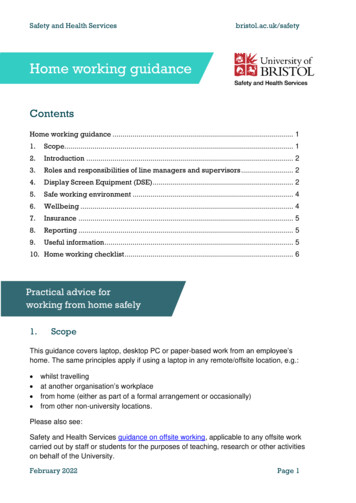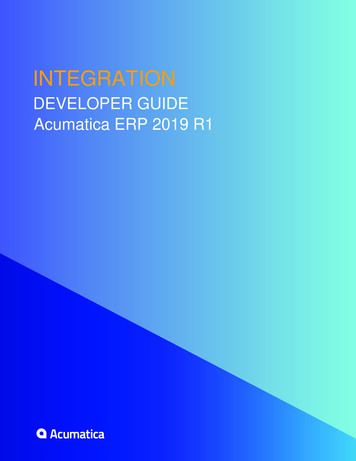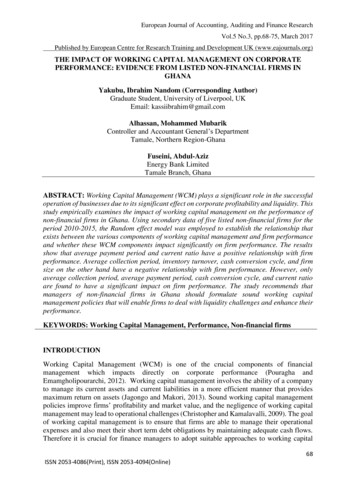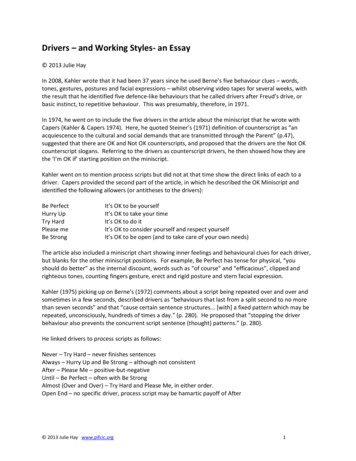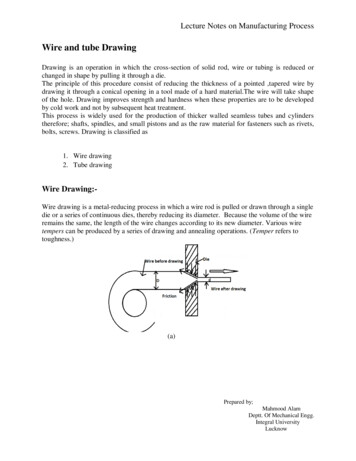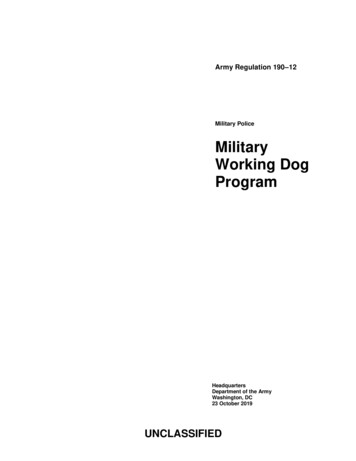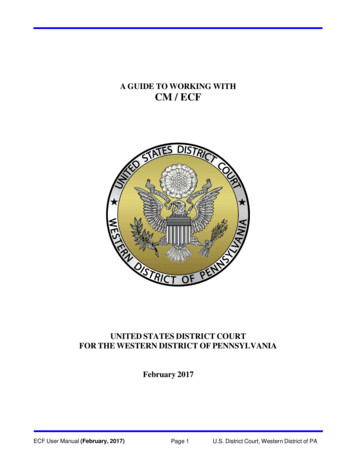
Transcription
A GUIDE TO WORKING WITHCM / ECFUNITED STATES DISTRICT COURTFOR THE WESTERN DISTRICT OF PENNSYLVANIAFebruary 2017ECF User Manual (February, 2017)Page 1U.S. District Court, Western District of PA
Table of ContentsHelp Desk . 5ECF System Capabilities . 5Requirements . 5CLEARING TEMPORARY FILES/HISTORY IN INTERNET EXPLORER . 6Scope of Electronic Filing. 6Sealed Documents . 7Special Filing Requirements and Exceptions . 7ELIGIBILITY, REGISTRATION AND PASSWORDS . 9PACER REGISTRATION. 10ECF TRAINING . 10Consequences of Electronic Filing . 10Entry of Court Orders and Related Papers . 11Notice of Court Orders and Judgments . 11Signatures. 11Service of Documents by Electronic Means . 121.Service of Process . 122.Other Types of Service . 12Retention Requirements . 13Preparation . 13Setting Up Adobe Acrobat PDF Reader . 13Portable Document Format (PDF/A) . 13Viewing a PDF/A Document . 13Converting Electronic Documents to PDF/A Format . 14Creating a PDF/A with Adobe . 14Creating a PDF/A with Microsoft Word . 17Creating a PDF/A from a Scanned Document Using Adobe. . 18Basics of the electronic case filing (ecf) system . 20User Interactions . 20Conventions used in this Manual: . 20Incorrectly Filed Documents. 20Initiating Documents. 20User Manual . 21Entering the ECF System . 21Logging In . 23Selecting ECF Features . 24General Rules and Manipulations . 25Manipulating the Screens . 25Naming Conventions . 25Adding Parties (Plaintiff, Defendant, etc.) to a Case . 25Adding Attorney Name/Firm/Address to a Case . 25Judgment Index Entries . 26Correcting a Mistake. 26How To File Initial Papers and/or Documents in Civil, Criminal and Miscellaneous Cases . 26Filing an Initial Pleading in a Civil or Miscellaneous Case . 27Erie:1:05mc2025 . 27Pittsburgh: 2:05mc2025 . 27Johnstown: 3:05mc2025. 27ECF User Manual (February, 2017)Page 2U.S. District Court, Western District of PA
Filing a Motion or Other Type of Document . 291. Select the Type of Civil Event that is being filed. . 292. Locate the Case for Which the Document is Being Filed . 303. Designate the Parties for Whom the Document is Being Filed . 314. Specify the PDF/A Document to File . 315.Filing Attachments and Exhibits . 34File Size Limitation:. 34Page Limits . 34How to Add Attachments and Exhibits To Documents Being Filed. 346.Refining Docket Text . 357.Submit Document For Filing . 368.Notice of Electronic Filing . 36E-Mail Notification of Documents That Were Filed. 38Filing Other Types of Documents . 38Filing Documents If ECF Is Not Accessible (Technical Failures) . 38PUBLIC ACCESS . 39Sensitive Information . 39Hyperlinks . 40Query Feature. 41Selecting a Case to Query . 41Attorney . 42Case Summary . 42Docket Report . 43History/Documents . 44Other Queries . 45Reports Feature . 45Docket Sheet Report . 46Utilities Feature . 46Your Account . 47View Your Transaction Log . 50Miscellaneous . 51Logout . 51Exhibit A. 52Electronic Case Filing (ECF) . 52Attorney registration . 52Exhibit B . 53CONFIDENTIALITY AND PROTECTIVE ORDERS IN CIVIL MATTERS . 53ORDER . 53Exhibit C . 54NOTICE OF INTENT TO REQUEST REDACTION OF SPECIFIC PERSONALDATA IDENTIFIERS . 54Exhibit D. 55VERIFICATION OF TECHNICAL FAILURE FILER’S EQUIPMENT . 55ECF User Manual (February, 2017)Page 3U.S. District Court, Western District of PA
GETTING STARTEDIntroductionThis manual provides procedures and instructions for using the Electronic Case Files (ECF) system to filedocuments with the court or to view and retrieve docket sheets and documents for all civil, criminal andmiscellaneous cases in the system. A Filing User should have a working knowledge of an ECF-compatibleweb browser and Adobe Acrobat or equivalent software for creating and reading Portable Document Files(PDF/A).The following definitions are used throughout this User Manual:1.1 “Electronic Filing System” refers to the court’s automated system that receives and storesdocuments filed in electronic form. The program is part of the CM/ECF (Case Management /Electronic Case Files) software that was developed for the Federal Judiciary by the AdministrativeOffice of the United States Courts.1.2 “Filing User” is an individual who has a court-issued login and password to file documentselectronically.1.3 “Notice of Electronic Filing” (NEF) is a notice automatically generated by the Electronic FilingSystem at the time a document is filed with the system, setting forth the time of filing, the name of theparty and attorney filing the document, the type of document, the text of the docket entry, the name ofthe party and/or attorney receiving the notice, and an electronic link (hyperlink) to the filed document,which allows recipients to retrieve the document automatically.1.4 “PACER” (Public Access to Court Electronic Records) is an automated system that allows anindividual to view, print and download court docket information over the Internet.1.5 “PDF/A” refers to Portable Document Format for long-term archiving. A document file createdwith a word processor, or a paper document that has been scanned, must be converted to portabledocument format “PDF/A” to be filed electronically with the court. Converted files contain theextension “.pdf”.1.6 “Proposed Order” is a draft document submitted by an attorney for a judge’s signature. A proposedorder shall accompany a motion or other request for relief as an electronic attachment to the document.1.7 “Technical Failure” is defined as a malfunction of court owned/leased hardware, software, and/ortelecommunications facility which results in the inability of a Filing User to submit a filingelectronically. Technical failure does not include malfunctioning of a Filing User’s equipment.ECF User Manual (February, 2017)Page 4U.S. District Court, Western District of PA
Help DeskCall the Pittsburgh’s Intake desk at (412) 208-7500 for telephone assistance in using ECFbetween the hours of 8:30 A.M. and 5:00 P.M., Monday through Friday.Questions involving a matter or case in Erie or Johnstown, please contactErie Division (814) 464-9600 or Johnstown Division (814) 533-4504ECF System CapabilitiesA Filing User with a PACER account, an ECF-compatible web browser, Adobe Acrobat or equivalentsoftware, and access to the Internet can use the court’s ECF system to perform the following functions: Open the court’s web page. View, print or download the most recent version of the ECF User Manual. Self-train on ECF using the ECF Tutorial, which is available on the district court’s ECF web site. Practice entering documents into ECF using a “training” system and database. The “training” ECFsystem is similar to the “live” ECF database. Electronically file pleadings and documents in actual cases. View official docket sheets and other documents associated with cases. View reports for cases that were filed electronically.RequirementsHardware and Software RequirementsThe hardware and software needed to electronically file, view, and retrieve case documents are thefollowing: A personal computer running a standard operating system such as Microsoft Windows orMacintosh. A word processing software package such as WordPerfect or Microsoft Word. Adobe Acrobat software (Reader & Writer) to convert documents from the format of their nativeapplication to portable document format (PDF/A). Adobe Acrobat Writer is included inWordPerfect’s Version 9 or higher and Microsoft Word version 2007 or higher. A scanner to convert paper documents that are not in a word processing format to digital format forelectronic filing in the court’s ECF system (e.g. medical records filed as exhibits). Use a scannerONLY if you cannot electronically prepare your documents with a word processing softwarepackage and convert them to PDF/A format. When scanning documents for ECF, scan at aresolution of 200 to 240 dpi. Scanning at resolutions greater than 240 dpi tends to clutter theelectronic transfer with unwanted markings and print. All documents should be scanned with a“black and white” setting unless the exhibit is colored. An Internet service provider and web browser. The court has verified that its installed version ofECF is compatible with Microsoft’s Internet Explorer version 5.5 or higher.ECF User Manual (February, 2017)Page 5U.S. District Court, Western District of PA
Users of ECF have experienced some compatibility issues with versions of Netscape Navigatorlower than 4.7; America On-Line’s version of Netscape Navigator; and versions of InternetExplorer other than Version 5.5. Any version of Internet Explorer requires the user to clear thetemporary Internet files/history of the web browser each time ECF is accessed. This will ensureweb pages viewed within ECF display all available options.CLEARING TEMPORARY FILES/HISTORY IN INTERNET EXPLORERFollow the steps below before accessing ECF. Open Internet Explorer and select Tools. Select Internet Options. In the Temporary Internet Files section, select “delete files”.Scope of Electronic FilingAll civil, criminal and miscellaneous cases shall be assigned to the Electronic Filing System. Exceptas expressly provided herein or by order of court, or in exceptional circumstances including technicalfailures, a Filing User shall electronically file all documents required to be filed with the court.The filing of initial papers may be accomplished either electronically under procedures outlined inSection entitled “How to File Initial Pleadings/Documents” in this manual or for pro se litigants,traditionally on paper. In a case removed to the federal court, parties are required to provide electroniccopies of all documents previously filed in the state court. Service of the summons and complaintmust be made under Federal Rule of Civil Procedure 4.A party who is not represented by counsel may file papers with the clerk in the traditional manner, butis not precluded from filing electronically.All attorneys listed on the docket, including “of counsel” and those admitted pro hac vice, mustbecome registered users or else they must show cause why they are not a registered user.SANCTION/PROCESSING FEEIf an attorney insists on filing a document on paper and is a Registered ECF user, Intakewill notify the Judge of such filing and the Judge will enter and Order RequestingProcessing Fee and Sanction.ECF User Manual (February, 2017)Page 6U.S. District Court, Western District of PA
Sealed DocumentsA document subject to a sealing order must be filed in the traditional manner on paper in a sealedenvelope marked “sealed” accompanied by a disk or CD-ROM containing the document in PDF/Aformat. Only the motion to file a document under seal may be filed electronically, unless prohibited bylaw. The order of the court authorizing the filing of document(s) under seal may be filed electronically,unless prohibited by law. After the filer receives court approval to file a document under seal, it is thefiler’s responsibility to present the document to the clerk’s office for filing in the traditional manner onpaper in a sealed envelope marked “sealed” and with appropriate court and case identifyinginformation, accompanied by a disk or CD-ROM containing the document in PDF/A format.If the court grants leave for a party to file a document under seal, the document can be filed in theclerk's office by presenting the document on paper AND in PDF/A format on disc or CD-ROM OR, inthe alternative, e-mailing the PDF/A document as an attachment to the Intake Section of the Clerk'sOffice.If a filer prefers to e-mail the document for filing, he/she must first phone the intake section of theappropriate division for instruction and the e-mail address. This is the court's ONLY exceptionconcerning the use of e-mail relative to filing a document electronically and is handled on anindividual basis.The filer should also remember that if the document is to be served on other parties, service is to beperformed in the traditional manner since access to the document itself in ECF will not be permitted toanyone. The NEF is delivered, however, the document cannot be viewed, printed, saved, etc.Clerk's Office Intake Phone NumbersPittsburgh: (412) 208-7500Erie:(814) 464-9600Johnstown: (814) 533-4504Refer to this Court’s policy governing all sealed matters- Misc. No. 05-45 (See Exhibit B).Special Filing Requirements and ExceptionsI.Special Filing RequirementsThe documents listed below shall be presented for filing in the traditional manner onpaper and accompanied by a disk or CD-ROM containing the document in PDF/Aformat:Sealed (subject to policy on sealed matters – Misc. No. 05-45 - Exhibit B)Cases filed sealed by STATUTE (such as, Qui Tam Cases).II.ExceptionsIn addition to the provision in LCR49D, the following are excluded from the ElectronicFiling System and shall be filed solely on paper:ALL GRAND JURY MATTERS:The following documents are examples of grand jury matters:ECF User Manual (February, 2017)Page 7U.S. District Court, Western District of PA
1) Motion to Empanel Grand Jury and orders ruling on them;2) Motions to Quash Grand Jury subpoenas and orders ruling on them;3) Motions to Enforce Grand Jury subpoenas and orders ruling on them;4) Motions for immunity and orders ruling on them;5) Motions for appointment of counsel before a Grand Jury and ordersruling on them.III.Social Security Administrative Transcripts shall be filed electronically by the U.S.Attorney’s Office.IV.Original State Court Records presented in 28 U.S.C. Section 2254 cases shall befiled in the traditional manner on paper. Records received will be noted on the docket,however, but will not be available for view electronically. State Court records are NOTpart of this court’s permanent case file and are returned to the appropriate State Courtupon final disposition.V.Transcripts of this Court (both civil and criminal) shall be filed electronically inPDF/A format. The Judicial Conference has established a policy on electronicavailability before making official transcripts of court proceedings electronicallyavailable to the general public. The policy establishes a procedure whereby counsel canrequest the redaction from the transcript of specific personal data identifiers before thetranscript is made electronically available to the general public.A party must file a Notice of Intent to Request Redaction of Specific Personal DataIdentifiers within 7 CALENDAR days of the filing of the official transcript by the courtreporter. Note: If a party fails to request redaction of specific personal data identifierswithin this time frame, the transcript will be made electronically available (remotely)without redaction. Neither the court nor court reporters will review the originaltranscript for specific personal data identifiers. A Notice of Intent to Request Redactionof Specific Personal Data Identifiers form is available on the court’s website athttp://www.pawd.uscourts.gov. (See Exhibit C).If a party files a Notice of Intent to Request Redaction of Specific Personal DataIdentifiers, the transcript will not be made remotely electronically available to thegeneral public until the party submits a statement of redaction of specific personal dataidentifiers to the court reporter/transcriber and the redactions are made. Note: A copyof the officially transcribed transcript may be purchased from the courtreporter/transcriber or the clerk’s office during this time and will be available forviewing on the public terminals in the clerk’s office.Following the filing of a Notice of Intent to Request Redaction of Specific PersonalIdentifiers, the parties have 21 CALENDAR days from the date the transcript is filedwith the clerk, or longer IF ordered by the court, to submit a statement to the courtreporter/transcriber indicating where the specific personal data identifiers appear in thetranscript by page and line and how they are to be redacted. See 14.1 of the court’sCM/ECF Policies & Procedures concerning Redacted Identifiers. The courtECF User Manual (February, 2017)Page 8U.S. District Court, Western District of PA
reporter/transcriber shall have 31 CALENDAR days from the date of submission of therequest for redaction of specific personal data identifiers to electronically file theredacted transcript. Note: If a party fails to submit the statement within this time frame,the transcript will be made electronically available without redaction of specific personaldata identifiers after 90 CALENDAR days.ELIGIBILITY, REGISTRATION AND PASSWORDSAn attorney admitted to the Bar of this court, including an attorney admitted pro hac vice, may registeras a Filing User by completing and submitting the prescribed electronic registration form on thecourt’s web site at CFProc/RequestID.cfm.Registration as a Filing User constitutes consent to electronic service of all documents as provided inthe court’s order dated April 20, 2005 at Misc. No. 05-186 in accordance with the Federal Rules ofCivil Procedure and the Federal Rules of Criminal Procedure.A person who is a party to an action and who is not represented by an attorney may register as a FilingUser in the Electronic Filing System solely for purposes of the action. If during the course of theaction the person retains an attorney who appears on the person’s behalf, the attorney must advise theclerk to terminate the person’s registration as a Filing User upon the attorney’s appearance.When registering as a Filing User, an individual must certify that ECF training has been completed. Anindividual may register more than one Internet e-mail address. Once the clerk processes the registration,the Filing User will receive notification of the user login and password. A Filing Usershall protect the security of the User’s password and immediately notify the clerk if the Filing Userlearns that the password has been compromised.Once registration is complete, a Filing User may not withdraw from participation in the ElectronicFiling System except by leave of court.Once registered, a Filing User shall be responsible for maintaining his/her account, including, but notlimited to change of address, firm, phone number, email notification address, tAfter processing the properly completed registration form, the clerk’s office will open a user account andcontact you through e-mail with your ECF system login and password. Informing registered users by email will ensure that the court has the proper e-mail address.If you have forgotten your ECF password and/or login, you may request to have this information sent to your emailaddress. This address is case sensitive and must match the primary address for the account.A new password will be generated, and it is highly recommended that you change it immediately following a successfullogin.The request is located at:http://www2.pawd.uscourts.gov/Applications/pawd adr/pages/PasswordRequest.cfmECF User Manual (February, 2017)Page 9U.S. District Court, Western District of PA
PACER REGISTRATIONECF users must have a PACER account. If you do not have a PACER login, contact the PACER ServiceCenter to establish an account. You may call the PACER Service Center at (800) 676-6856 or (210) 3016440 for information or to register for an account. Also, you may register for PACER online athttp://pacer.psc.uscourts.gov.ECF TRAININGIndividuals can log into the court’s ECF training database on the Internet athttps://ecf-train.pawd.uscourts.gov to practice ECF filing. The court also offers the followingECF training:1)Training classes are held at the courthouses in Pittsburgh, Johnstown and Erie. The training isconducted by the clerk’s office and you may obtain the training schedule by visiting the court’sweb site at www.pawd.uscourts.gov.2)ECF Tutorial - Computer Based Training (CBT) available on-line at the court’s web site.3)On-site training at a law firm can be arranged through the clerk’s office.To register for class training, please use the registration form found on our website at:http://www.pawd.uscourts.gov/cm-ecf-trainingWe strongly recommend that Filing Users practice in the “training” ECF database before filing documentsin the “live” ECF database.Access to the training database is authorized with the following logins and user2user3user4Consequences of Electronic FilingElectronic transmission of a document to the Electronic Filing System in accordance with this Court’sElectronic Case Filing Policies and Procedures, together with the transmission of a Notice of ElectronicFiling from the court, constitutes filing of the document for all purposes of the Federal Rules of CivilProcedure, the Federal Rules of Criminal Procedure and the Local Rules of this court, and constitutes entryof the document on the docket kept by the clerk under Fed.R.Civ.P. 58 and 79, and Fed.R.Crim.P. 49 and55.When a document has been filed electronically, the official record of that document is the electronicrecording as stored by the court, and the filing party is bound by the document as filed. A documentfiled electronically is deemed filed on the date and time stated on the Notice of Electronic Filing fromthe court.THE FACT THAT A PARTY FILES A DOCUMENT ELECTRONICALLY DOES NOT ALTER THE FILING DEADLINEFOR THAT DOCUMENT. ELECTRONIC FILING MUST BE COMPLETED BEFORE MIDNIGHT EASTERN TIME INECF User Manual (February, 2017)Page 10U.S. District Court, Western District of PA
ORDER TO BE CONSIDERED TIMELY FILED THAT DAY. IN ACCORDANCE WITH RULE 6(E) OF THE FEDERALRULES OF CIVIL PROCEDURE AND RULE 45(C) OF
ECF User Manual (February, 2017) Page 1 U.S. District Court, Western District of PA . A GUIDE TO WORKING WITH. CM / ECF. UNITED STATES DISTRICT COURT. FOR THE WESTERN DISTRICT OF PENNSYLVANIA. February 2017. ECF User Manual (February, 2017) Page 2 U.S. District Court, Western District of PA .




